 Diamonds are eternal, just like the bond with your life partner. That’s why these sparkling rocks are the one and only choice for an engagement ring.
Diamonds are eternal, just like the bond with your life partner. That’s why these sparkling rocks are the one and only choice for an engagement ring.
Proposals can leave you in a bundle of nerves but what’s even more stressful is getting the right ring for her. Diamonds come in a variety of clarities, sizes, shapes and cuts and you can pay an arm and a leg for them. Since you are probably going to invest a huge part of your savings on an engagement ring, you should know about some stunning diamond cuts which would surely make her say ‘yes!’
Walking into a jeweler’s shop can be a bit intimidating. One can easily get confused when surrounded by all the different cuts and designs. Before delving into the cuts, it’s important to distinguish between the cut and the shape. The shape is the geometric appearance of the gemstone, whereas a cut is what makes a diamond bright and shiny. A gemstone sparkles when light reflects from it.
Interesting fact: The engagement ring phenomenon dates back to the early days of American exploration. The Puritans had a practice whereby the man would present a thimble to the woman of his dreams for marriage. Yes, a sewing thimble! It seemed to be the practical thing at the time, but once they got married, the wife would cut the thimble into a thin round piece of metal, which in turn she would place on her finger and thus, the wedding band was born.
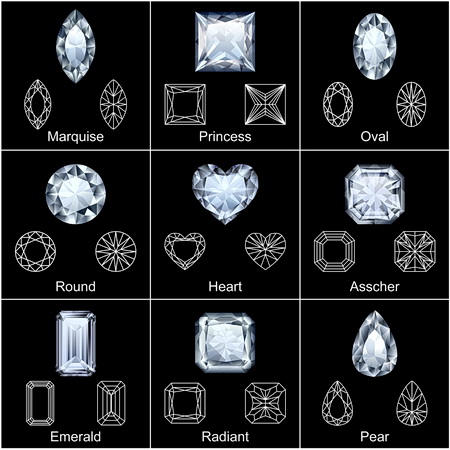
The facets (flat surfaces that allow more light to be reflected; hence, more brilliance) and angles (how the facets are placed on the gem to bring in the most light), their quantity, symmetry, and proportions are all responsible for the reflection of light. A diamond is intricately cut to maximize this reflection, but not all diamonds are equal. Some have fewer quality cuts than others and hence the price difference you will see as you shop, but the better the cut, the more brilliance, the more she will like it, but the more you will pay for it.
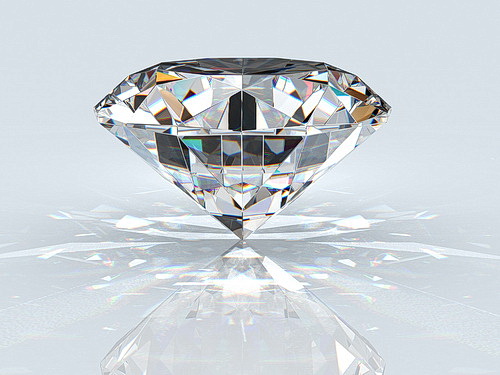
Cutting a diamond too shallow would allow most of the light to pass through the bottom, making this an extremely poor cut. If cut too deep, a diamond would reflect light from its sides and would fail to produce the required gleam and glitter.
A perfectly cut diamond would reflect all its light from its top face and would shine brilliantly. The more radiant a diamond appears, the more expensive it will be.
Now, let’s look at the ten most popular diamond cuts that would be perfect for an engagement ring.
Round Cut
This cut is one of the most popular and most famous types of cut for engagement rings. About 50% of engagement rings have a round cut diamond. This particular cut gives maximum shine to the diamond, partially due to the large amounts of facts (58) and the ideal position at which they are set. You’ll find a range of grades, styles, and settings for a round cut diamond. A simple gold or platinum ring with an isolated round-cut diamond looks like a personification of “beauty lies in simplicity”. You can also try a solitaire setting to add glamour to this cut.
Round cut diamonds are considered the most expensive of the cut variations, but they display the most brilliance. You can’t go wrong with a round cut diamond.
Princess Cut

Also known as a square modified brilliant cut, the princess cut is a popular choice for engagement rings. First created by Betazel Ambar and Israel Itzkowitz in 1980, princess cuts appear like a square or rectangle from the top.
It has four beveled sides and a bottom that resembles an inverted pyramid. You’ll find this cut in 30% of the rings. It looks a bit familiar to the Asscher or Emerald cut but it has more facets at the top as opposed to the flat top face of Asscher.
Emerald Cut

This cut derives its name from the famous gemstone emerald because these stones are usually cut in this manner. However, this cut looks equally classy for diamonds. It is a stepped cut that seems to have an aura of enduring beauty. Its top face is a narrow rectangle with trimmed corners. Since this cut is not used as frequently as a round or princess cut, it is relatively inexpensive and so a ring with a high-grade emerald cut diamond will cost you less or if you were going to sell one, you won’t get what you would get if you had a round cut stone; however, those with smaller hands prefer the emerald cut because it makes their fingers look longer.
Oval Cut

Oval cut exhibits a classic and traditional impression. This cut has gained popularity in recent years. It beautifies the hand as it has a lengthening effect. The oval cut is a great choice for East-West trendy rings. It is about 25% more affordable than a round cut diamond ring. Its greater surface area makes the diamond appear bigger. However, an oval cut has one undesirable feature called ‘the bow-tie effect’ which means the cut will show a darker area in the middle if one looked down upon it. The greater the bow tie effect, the poorer the stone quality. Excellent quality diamonds will have a very subtle darker region.
Asscher Cut
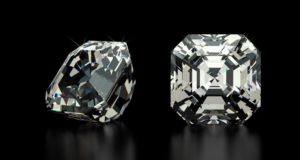
Created in the early 1900s, it came into light in the 1920s. It was named after its creators the Asscher Brothers who ran Holland’s Asscher Diamond Company which later became the Royal Asscher Diamond Company. It was an attractive cut with a vintage feel about it. Similar to an emerald cut, it has a square or rectangular appearance with cropped corners. It has 74 large step facets and a high crown which makes yields more brilliance than the emerald cut. It is set in a four-prong setting and reflects light like a never-ending corridor lined with mirrors on all sides.
Cushion Cut

A cushion-cut, also known as a pillow cut, is made to emphasize clarity. This cut is almost 200 years old which gives it a vintage flair. On the other hand, it looks extremely stylish and modern with a square top face with rounded corners. To further elevate this symbol of understated love, you can mount it in a halo setting for a perfect engagement ring.
Marquise Cut
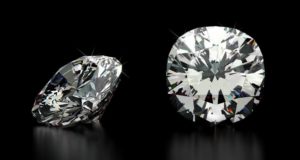
Considered bold and beautiful, Marquise cut is also known as the football-shaped cut, the eye-shaped cut, and the boat-cut. It exudes a dramatic persona with an elliptical shape with pointed ends and 58 facets. Its French history is as interesting as the cut itself. Back in the 18th century King Louis XV of France ordered a jeweler to design a cut inspired by his mistress’ lips. A diamond ring in this cut would require multiple prongs and a setting that can act as a stable base for the stone.
Radiant Cut
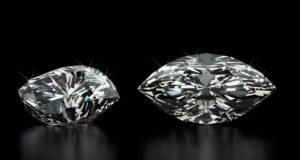
A radiant cut gets its name from its matchless radiance. Since a radiant cut diamond has numerous facets, it reflects light in all directions and appears luminous. This cut also has a square or rectangle shape with trimmed corners. Looking directly into the top face of the stone would reveal a circular pattern in the center.
Pear Cut
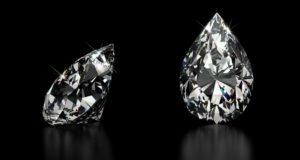
This would be an ideal cut for those looking for something elegant and sophisticated. The pear cut has the best features of marquise and round cut diamonds. It is so beautifully proportioned that it looks like an angel’s teardrop. It makes the hand appear slender due to its pointed corner. The cut makes the diamond look bigger than it actually is.
Heart Cut
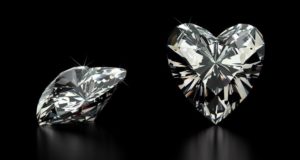 A heart cut diamond looks very exquisite and lovely. When buying a ring with a heart-cut diamond, make sure you check its proportions closely. Give enough attention to the body and the cleft of the heart shape. This cut would require a setting with more prongs.
A heart cut diamond looks very exquisite and lovely. When buying a ring with a heart-cut diamond, make sure you check its proportions closely. Give enough attention to the body and the cleft of the heart shape. This cut would require a setting with more prongs.
So there you have it. The diamond cuts, their variety and price ranges. Do you know what to buy her now? If not, check out our article on the 4 Cs of diamonds. By then, you can consider yourself an expert or at least have enough knowledge to get the right diamond ring that she will never forget!
